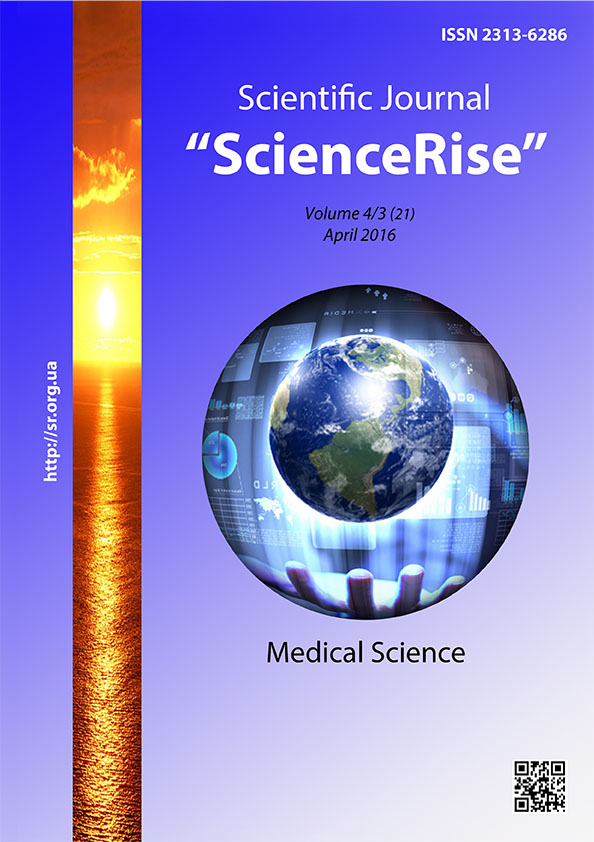Features of changes for ulnar nerve F-wave during dynamic observation of the patients with acute ischemic stroke
DOI:
https://doi.org/10.15587/2313-8416.2016.67689Keywords:
post-stroke spasticity, F-wave, spinal motoneurons excitability, dynamic changesAbstract
F-wave is a motor response of the muscle to the supramaximal electrostimulation and by its physiological nature presents a muscle response to the reciprocal excitation that occurs in the result of antidromic excitation of spinal motoneurons. Thereby, F-wave’s parameters characterize the functional state of spinal motoneurons depending on the spinal and supraspinal influences they are exposed to.
The aim of this study was to evaluate dynamic alterations in F-wave parameters in stroke survivors on the 1-3rd, 19-21st days and during the 6th month, depending on the presence or absence of post-stroke spasticity.
Methods. 97 patients with first-ever cerebral ischemic stroke were included. For spinal motor neurons excitability ulnar nerve F-wave was investigated (F mean ampl F/Mmax). During the 6th month patients were divided into 2 groups: those who developed post-stroke spasticity and without it. Mann-Whitney test was used to define significant changes between groups. p<0,05 was determined as a considerable level.
Results. In the current study we observe that patients who do not develop post-stroke spasticity on the 6th month had a significant decrease of ulnar nerve F-wave’s parameters on the paretic side on the 1-3th day after stroke, comparing to the patients with spasticity, who did not show a significant decrease. At the end of acute phase and during the 6th month both groups of patients showed gradual increase in spinal motoneuron’s excitability on the paretic side, but it was less pronounced in patients without spasticity.
Conclusions. Investigated changes in spinal motoneurons excitability between patients who in 6 month suffer from post-spasticity and who do not can be used for developing predictors of spasticity subsequently.References
Lundstrom, E., Smits, A., Agostini, M. et al. (2010). Muscle synergy patterns as terminals of spasticity during the first six month following first-ever stroke. J Rehabil Med, 42, 296–301.
Sommerfeld, D. K. (2003). Spasticity After Stroke: Its Occurrence and Association With Motor Impairments and Activity Limitations. Stroke, 35 (1), 134–139. doi: 10.1161/01.str.0000105386.05173.5e
Wissel, J., Schelosky, L. D., Scott, J., Christe, W., Faiss, J. H., Mueller, J. (2010). Early development of spasticity following stroke: a prospective, observational trial. J Neurol, 257 (7), 1067–1072. doi: 10.1007/s00415-010-5463-1
Urban, P. P., Wolf, T., Uebele, M., Marx, J. J., Vogt, T., Stoeter, P. et. al. (2010). Occurence and Clinical Predictors of Spasticity After Ischemic Stroke. Stroke, 41 (9), 2016–2020. doi: 10.1161/strokeaha.110.581991
Leathley, M. J., Gregson, J. M., Moore, A. P., Smith, T. L., Sharma, A. K., Watkins, C. L. (2004). Predicting spasticity after stroke in those surviving to 12 months. Clinical Rehabilitation, 18(4), 438–443. doi: 10.1191/0269215504cr727oa
Watkins, C., Leathley, M., Gregson, J., Moore, A., Smith, T., Sharma, A. (2002). Prevalence of spasticity post stroke. Clinical Rehabilitation, 16 (5), 515–522. doi: 10.1191/0269215502cr512oa
Lundström, E., Terént, A., Borg, J. (2008). Prevalence of disabling spasticity 1 year after first-ever stroke. European Journal of Neurology, 15 (6), 533–539. doi: 10.1111/j.1468-1331.2008.02114.x
Matvienko A. U. (2008). Spastichnist. Meduzuna svity, 4, 131–143.
Nikolaev, S. G. (2003). Praktikum po klinicheskoy electromyographyi. Ivanovo, Ivan. gos. med. academia, 264.
Drovy V. E., Neufeld M. Y., Korczyn A. D. (2003). F-wave characteristics following acute and chronic upper motor neuron lesions. Electromyogr Clin Neurophysiol, 33 (7), 441–446.
Mesrati, F., Vecchierini, M. F. (2004). F-waves: neurophysiology and clinical value. Neurophysiologie Clinique/Clinical Neurophysiology, 34 (5), 217–243. doi: 10.1016/j.neucli.2004.09.005
Downloads
Published
Issue
Section
License
Copyright (c) 2016 Angelika Payenok, Ірина Миколаївна Мітельман

This work is licensed under a Creative Commons Attribution 4.0 International License.
Our journal abides by the Creative Commons CC BY copyright rights and permissions for open access journals.
Authors, who are published in this journal, agree to the following conditions:
1. The authors reserve the right to authorship of the work and pass the first publication right of this work to the journal under the terms of a Creative Commons CC BY, which allows others to freely distribute the published research with the obligatory reference to the authors of the original work and the first publication of the work in this journal.
2. The authors have the right to conclude separate supplement agreements that relate to non-exclusive work distribution in the form in which it has been published by the journal (for example, to upload the work to the online storage of the journal or publish it as part of a monograph), provided that the reference to the first publication of the work in this journal is included.

